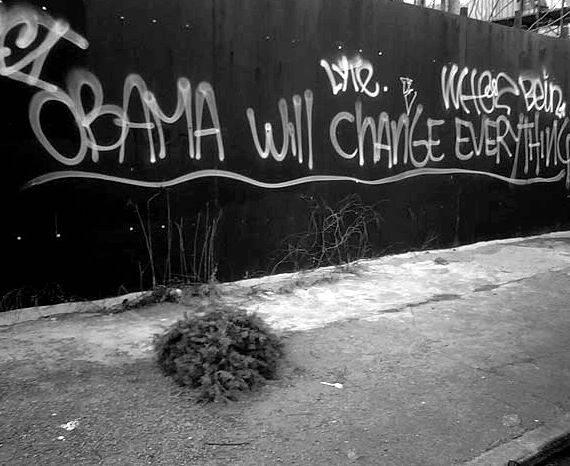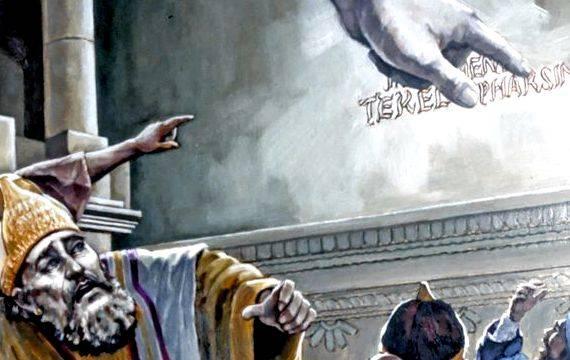Original caption: Two girls walk past a graffiti-strewn wall in the United Nations Relief and Works Agency for Palestine Refugees in the Near East (UNRWA)’s Acqba Jaber camp for Palestinian refugees in the West Bank, located just outside of Jericho
Original caption: Rocket-propelled war. a boy rides past graffiti in Gaza City after deadly air strikes on the territory.
Editor’s Overview
In this article, Julie Peteet offers an early example of the ways in which anthropologists have wrestled with the production (and implications) of graffiti as a political tool. Arriving in the West Bank in 1990, Peteet could not ignore the “writing on the walls” and sought out theoretical frameworks to discuss the role of graffiti during the first intifada. In this article she argues that different forms of cultural production, in this case graffiti, can act as a means of resistance and intervene on conditions or situations.
By carefully exploring the social life of graffiti, from the plans to produce it, to the acts themselves and the actions that follow, Peteet outlines the ways in which it mobilizes diverse groups of individuals (even those that appear to be seemingly homogenous) and can make visible various power relations and/or further solidify communities. Taking time to point out the specific role that youth play within the production of graffiti, Peteet considers the experiences of both young men and women who are compelled to write on the walls. During times of intense political violence, state surveillance, censorship and oppression, Peteet reminds the reader about the politics of reading and writing. This article, printed in 1996, serves as an early voice within the anthropological literature that asks the readers to (re)consider graffiti and the role it has in spaces of sustained conflict.
Over the past twenty years, Cultural Anthropology has published numerous articles that include discussions about the role of graffiti in sites of contestation and political turmoil (for example see: “Bombay Talkies, the Word and the World: Salman Rushdie’s Satanic Verses” Michael M. J. Fischer and Mehdi Abedi, Cultural Anthropology. May 1990, Vol. 5, No. 2: 107-159; “‘Visible Signs of a City Out of Control’: Community Policing in New York City”, Benjamin Chesluk, Cultural Anthropology. May 2004, Vol. 19, No. 2: 250-275). These articles offer a glimpse into the diverse landscapeswalls, streets, signsin which graffiti can be found and offer insights into the ways in which graffiti can be mobilized as a tool of expression and resistance.
About the Author
Julie Peteet is Associate Professor and Chair of the Department of Anthropology at the University of Louisville. Her work focuses on the political anthropology of the Middle East. She serves on the Board of Directors tot he Kentucky Refugees Ministries. Her recent book, Landscapes of Hope, Landscapes of Despair: Place and Identity in a Palestinian Camp focuses on role of place, space and identity in a Palestinian Refugee Camp.
Media and Visual Links
“The Writing on the Walls: The Graffiti of the Intifada” was written over 10 years ago, the following links are inspired by the article and seek to further the discussion and raise new questions about other forms of graffiti in the region.

Set 1 are links that provide additional background about others who are using visual media to explore issues in Palestine. Set 2 are links are about the visit by graffiti artist Banksy in 2005.
Graffiti from Bethlehem Wall
Peace and Freedom Youth Forum (send.a.message project)
US-Palestine Youth Solidarity Network
Image From. mideastyouth.com/wp-content/uploads/2006/09/pal04.jpg
Banksy has become a graffiti icon, from Bristol to LA, Disney to Gaza, you can often find his art–but not a face to the artist. His West Bank arrival was hailed by many as a way to publicize the plight of Palestinians. However, in a much publicized encounter, Banksy reported that he was approached by an elderly Palestinian man who told him that he was making the wall beautiful. Banksy thanked the older man, presuming this to be a compliment, only to be told “We don’t want this wall to be beautiful, we hate this wall. Go home.” The following links include media coverage of Banksy as well as examples of the large pieces he put up on the wall. Please see the “Questions for Class Assignments” for further discussion about the role of this artist in the popular imagination that surrounds the notion of graffiti at the West Bank.
Banksy from Channel 4
Raw Footage of Banksy (later used for Banksy on Channel 4)
Class Discussion Questions
1) Explain the argument that Peteet is making about the way in which graffiti acts as a vehicle or agent of power.
2) Peteet outlines the ways in which graffiti moved beyond the binaries of ‘occupied’ and ‘occupier’. Explain how graffiti was able to gain multiple audiences and Peteet’s understanding of the different, yet shared, experience for each.
3) Though the article accounts for both Palestinians and Israelis, the focus is on Palestinian experience. Please explain the different things graffiti could “do” for, and within, the Palestinian community.
4) Peteet offers that stones were the “weapon and medium” during the intifada, explain the relationship between stones and graffiti “in a battleground where technological disparity in weaponry was striking and an apparatus of censorship was in place” (141-142).
5) Peteet uses Fischer and Abedi’s notion of “minor media” to discuss graffiti, discuss her explanation of how Palestinian graffiti joined the electric age.
6) Explain the relationship between aesthetics and primacy. Further: Consider your answers to questions 5 6, how do you think graffiti differs in spaces of conflict relative to other spaces? If so, how and why?
7) Explore the role of policing and security in relationship to Palestinian graffiti.
8) Peteet states that graffiti acted as a rite of passage. In what ways was graffiti acting as a ‘test’ for young people? Please consider the role of gender in your answerdid the experience of young women differ from young men?Further: Reflecting on your answer to question 8, do you think that youth play a pivotal role in this form of cultural production? If so, how?
9) Please explore the power relations involved in the production of graffiti. Are there power brokers involved in graffiti production; are there unexpected experts that arise to produce certain types of graffiti for specific audiences? To aid in your answer you might want to re-read pages 144-145.
10) Why is it significant that groups, not individuals, sign the graffiti? Further: How is community being formed and asserted through the various processes involved in the production of graffiti? To assist, you might want to think of each step involved in the act and the role it has within the community.
11) Peteet is explicit in her declaration that graffiti is an act of defiance. Consider the various elements of graffiti (from preparation until it is covered over) and outline some of the moments in which it acts defiantly and the response it illicits from authorities.
12) Explore Peteet’s argument surrounding censorship and the idea of the “private nature of reading.” How did graffiti enter into this arena?
13) Peteet uses the works of Edward Said to explore the complexity of a text, and the role of the reader and the writer. Please explain the following passage and use examples from the text to support your explanation. “Who writes? For whom is the writing being done? In what circumstances. no one writes simply for oneself. There is always an Other, and this other willy-nilly turns interpretation into a social activity.” (150)Further: Consider your answer to questions 5,6, 13; Do you agree with Said, do you think there is always a politics to writing no matter the surface?
14) Explain the diversity in the readership of graffiti of both Palestinians and Israelis. In what ways did graffiti created a space of self-criticism and opened up debates.
15) After reading Peteet’s account of graffiti in the West Bank, how would you compare the work of graffiti artists such as Banksy (see youtube clips above) to the graffiti she describes in her article?
16) Consider your answer to question 15 and the controversy that surrounds the arrival Banksy in the West Bank; do you feel that the criticism of Banksy is justified, or do you feel that he is also writing for an audience and has a role to play in the West Bank?
Related Works
To see the ways in which this article has been used by other authors, please see the following essay that has cited this article:
Author’s Website






 Can animals think article by eugene linden summary writing
Can animals think article by eugene linden summary writing What is content article writing
What is content article writing Interesting topics for writing an article
Interesting topics for writing an article Writing solutions to the articles of confederation united
Writing solutions to the articles of confederation united Writing a newspaper article ppt viewer
Writing a newspaper article ppt viewer






